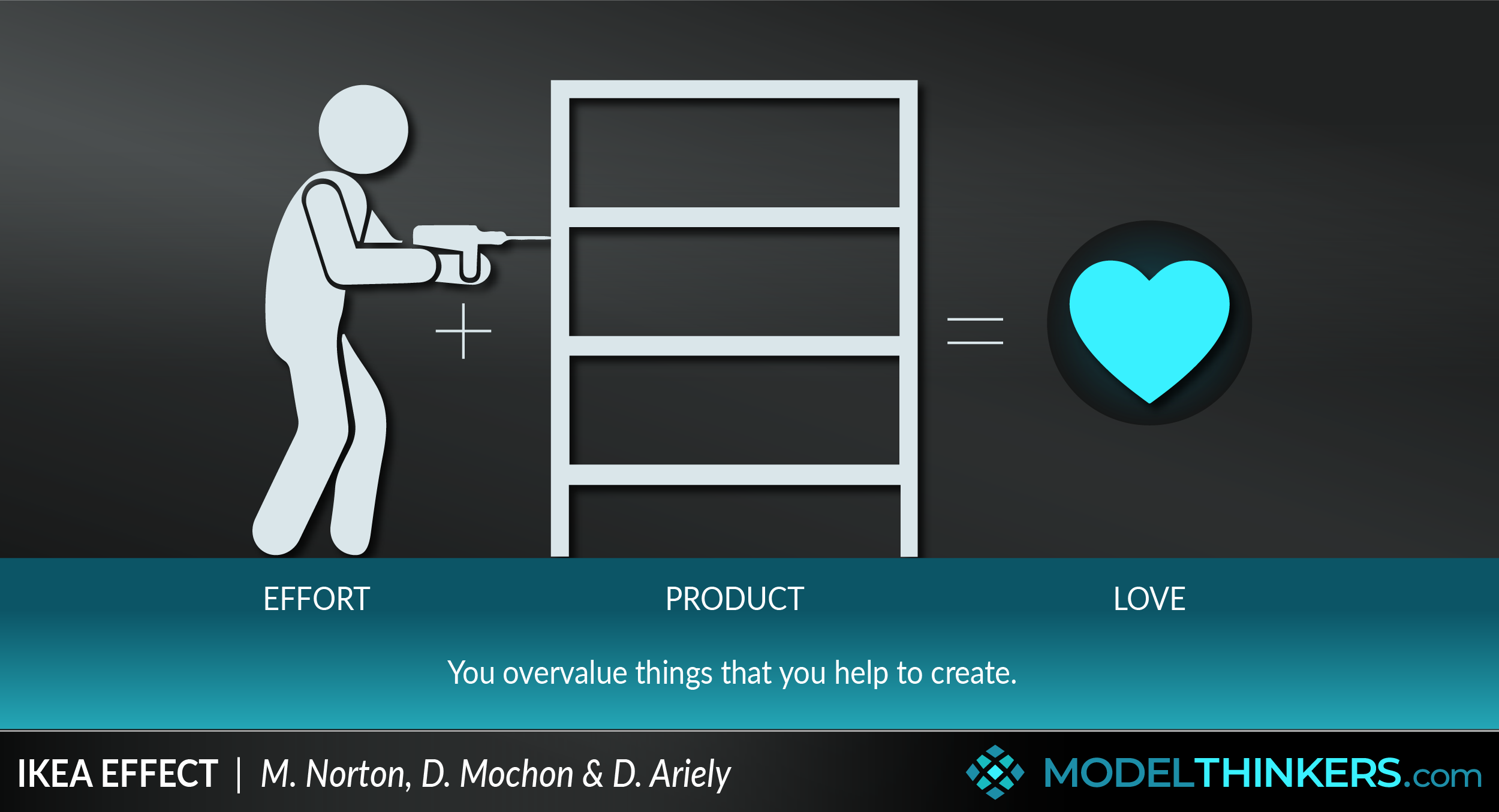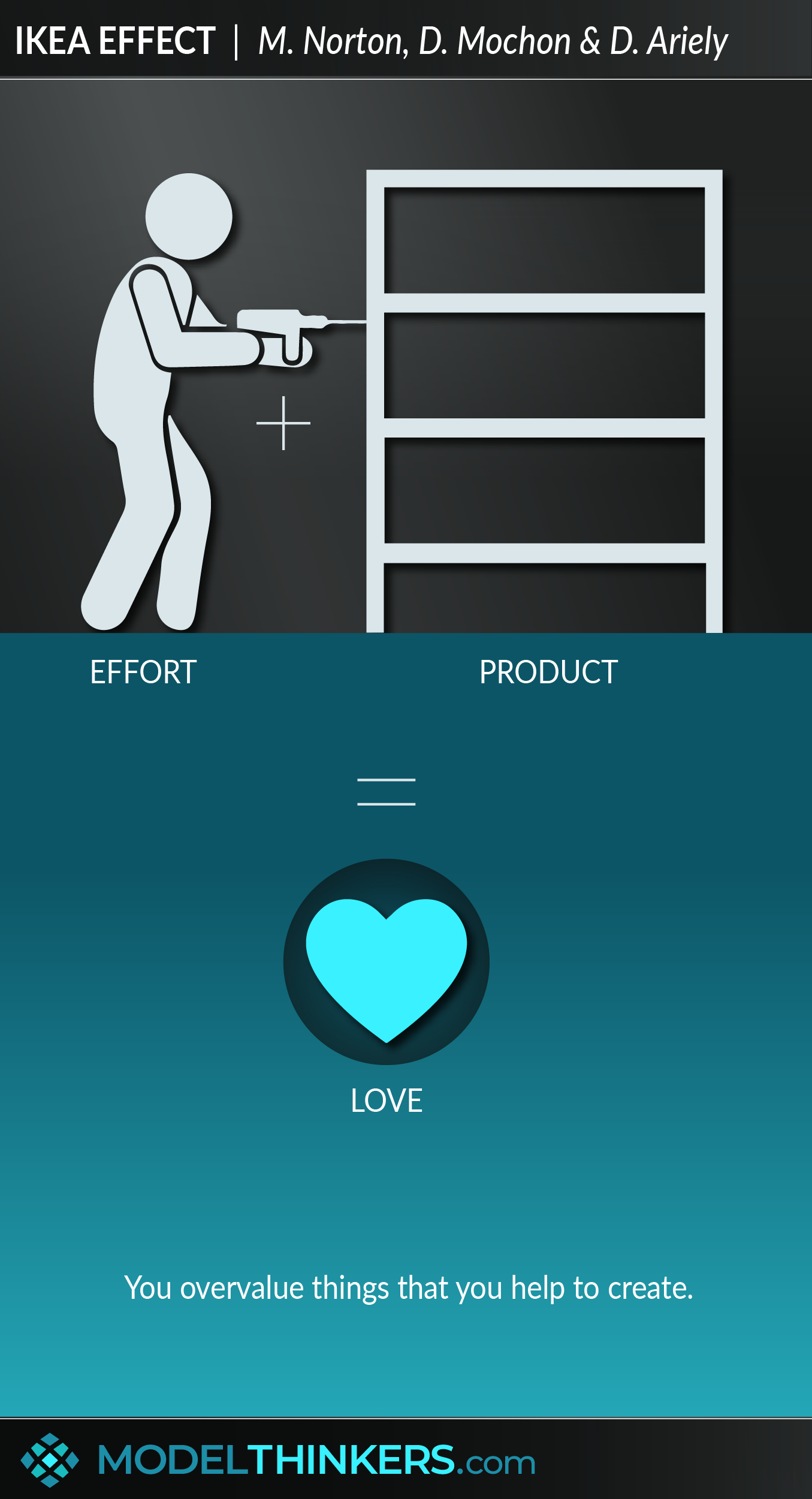

 0 saved
0 saved
 19.2K views
19.2K views








With a name inspired by the Swedish self-assembly furniture giant, this effect can help explain the growing popularity of ‘meal-kit’ services; the trend towards co-designing solutions in business; and house-hunters repeatedly paying top dollar for ‘fixer uppers’.
The IKEA Effect is a cognitive heuristic or bias that leads you to overvalue things that you’ve helped to partially create.
IMPLICATIONS FOR YOU.
This effect is quite intuitive. You’ve likely experienced the hollow feeling when something was simply handed to you, compared to the satisfaction of truly earning it. In addition, helping to create something can contribute to your self-beliefs of competency and impact.
In practical terms, the IKEA Effect can lead you to pay more for products that have a do-it-yourself element. Linked to that, the effect will lead you to overvalue those items once they have been constructed. See the Origins tab below for the fascinating Origami example from the paper that coined this term.
Dan Ariely, one of the originators of the term pushes the effect to its extremes, pointing out that if you have children, they generally represent “the ultimate IKEA Effect.” That is, you will value your own child, who you’ve put tremendous effort into over years, more than an equivalent child that you’ve not invested in. The IKEA Effect also explains why you tend to believe that everyone else should value your children as much as you.
IMPLICATIONS FOR BUSINESS STRATEGY.
Running a business or launching a new product? Consider how you might charge higher prices for assembly-based products, even though consumers are investing their own labour into the product’s completion. Importantly, this effect goes beyond the simple personalisation of choosing colours or options in a product, and instead must involve tangible effort to help create or build it.
INTERRUPTING THE IKEA EFFECT.
Like all heuristics, knowing about the IKEA Effect does not generally interrupt or prevent it. Some strategies to interupt the IKEA Effect include:
-
Obtain objective valuations: seek views of people who have not helped create something to assess the value of a product that you’ve helped to build.
-
Consider an equivalent product: identify or imagine what you’d pay for a similar product that you did not help to build.
-
Calculate the cost of your time: before buying a do-it-yourself product, consider the cost of your time and whether the price you are paying is fair, or whether the IKEA Effect is being leveraged against you.
It’s also worth understanding the effect to decide whether you want to accept it. Perhaps the effort and experience of building a product is something that you actually value — just remember that others can’t be expected to consider that value if you choose to sell it later.
IN YOUR LATTICEWORK.
This heuristic is better understood through the lens of Fast and Slow Thinking and associated heuristics such as Framing and Anchoring. Though of all heuristics, it is particularly related to the Endowment Heuristic which involves your tendency to overvalue your possessions.
A counter view, and potential limitation of this effect, comes via the Paradox of Choice — which would argue the need to simplify consumer experiences; and Activation Energy – which would suggest that you reduce barriers of entry and effort for customers to use your product or service.




-
Pause and think before buying do-it-yourself products.
Consider whether the product is good value or is it using the IKEA Effect against you? Calculate the cost of your time and whether an off-the-shelf product might work more effectively.
-
Seek a reality check on things that you helped to create.
If you are selling something that you helped to create, ask yourself: 'if I found something similar that I did not help build, what would I pay for it?'
-
As a business, use co-design and provide investment opportunities with your customers.
Consider how you might encourage your customers to invest their own time and energy to customise or complete your product or service.
As described in the summary of this model, one of the key challenges of trying to use the IKEA Effect in a business context are the combined risks of the Paradox of Choice and the potential block of Activation Energy.
From a personal perspective, you might argue that one aspect of the IKEA Effect is quite rational — that is, it’s reasonable to place higher value into something that you’ve expended effort into. Though it is irrational to expect others to place the same value on that object as you.
Build-A-Bear.
The Build-A-Bear business model provides reasonably expensive products that children and parents can create together.
The Meal-Kit business model.
Businesses such as Hello Fresh and Dinnerly are leveraging the IKEA Effect by offering set ingredients with relatively simple ‘construction instructions’ to put your meal together.
d
The idea behind this effect has been around for some time. According to the stories, in 1950 US Food company General Mills approached motivational psychologist, Ernest Dichter, to increase sales of its Betty Crocker instant cake mixes. According to the story, Dichter ran focus groups and made the recommendation to replace powdered eggs with fresh eggs to allow the cake maker to add their own value and feel as though they were creating something rather than simply buying it.
The story has been questioned, with other cake mixes on the market before or around that time, not to mention the obvious point — the fresh egg version might have sold more simply because it tasted better.
Nevertheless, the broader principle has been reaffirmed by a number of studies since and was consolidated in a 2011 academic paper by researchers Michael Norton (Harvard), Danial Mochon (Yale), and Dan Ariely (Duke). The paper shared the results of three studies, one involving IKEA boxes, one folded origami, and the final with built sets of Legos.
See below for some of the results, demonstrating that people who built Origami figures valued their creations almost as highly as expert-built versions, despite non-builders valuing those items considerably lower.
Interestingly, when the researchers removed instructions for some of the Origami builders — making it harder to make the objects and leading to a worse outcome. Those people even valued their outcome higher than those who were able to build it more simply.
Their study stated: “We demonstrate and investigate the boundary conditions for what we term the “IKEA effect” – the increase in valuation of self-made products. Participants saw their amateurish creations – of both utilitarian and hedonic products – as similar in value to the creations of experts, and expected others to share their opinions.”
There are a number of theories as to why the IKEA Effect occurs. These include:
-
The need to justify our labour: If we’ve invested in something we want to feel as though it was worth it, so we naturally add to the object's value to incorporate this.
-
The need to prove ourselves: the process of wanting to construct something helps to build confidence and a more positive self-view.
-
The building of ownership: Our investment of labour into an object deepens our ownership and sense that it is somehow an extension of ourselves.
In addition to the original paper that we've linked to above, you can find out more about the IKEA Effect from Dan Ariely’s video on the topic here.
 My Notes
My Notes
Oops, That’s Members’ Only!
Fortunately, it only costs US$5/month to Join ModelThinkers and access everything so that you can rapidly discover, learn, and apply the world’s most powerful ideas.
ModelThinkers membership at a glance:






“Yeah, we hate pop ups too. But we wanted to let you know that, with ModelThinkers, we’re making it easier for you to adapt, innovate and create value. We hope you’ll join us and the growing community of ModelThinkers today.”
































































































